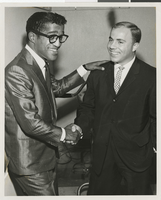Search the Special Collections and Archives Portal
Search Results

T-68 Donald Clark Collection. Series 1. NAACP, 1959-1962. Box 1, Folder 01. Clark, Donald Personal Ephemera, 1961-1963
Date
Archival Collection
Description
Series 1. NAACP, 1959-1962. Box 1, Folder 01. Clark, Donald Personal Ephemera, 1961-1963.
Text

T-68 Donald Clark Collection. Series 1. NAACP, 1959-1962. Box 1, Folder 02: NAACP Coordinating Council, 1959-1961
Date
Archival Collection
Description
Series 1. NAACP, 1959-1962. Box 1, Folder 02: NAACP Coordinating Council, 1959-1961.
Text

Photographs of Sammy Davis, Jr. off stage
Date
Archival Collection
Description
Group of black and white photographic prints of Sammy Davis, Jr. with various other performers off stage and in dressing room.
Image

MS 95-47 Alice Key Collection. Box 1, Folder 14: Newspaper clippings, 1966-2004 (2003 accretion)
Date
Archival Collection
Description
MS 95-47 Alice Key Collection. Box 1, Folder 14: Newspaper clippings, 1966-2004 (2003 accretion).
Text

MS 95-47 Alice Key Collection. Box 1, Folder 15: Correspondence and speeches, 1983-2004 (2003 accretion)
Date
Archival Collection
Description
MS 95-47 Alice Key Collection. Box 1, Folder 15: Correspondence and speeches, 1983-2004 (2003 accretion).
Text
Larry and Juanita Barr and Steven Gibson oral history interview
Identifier
Abstract
Oral history interview with Larry and Juanita Barr, with Steven Gibson conducted by Margery Waters on March 27, 1976 for the Ralph Roske Oral History Project on Early Las Vegas. The Barrs and Gibson talk about African Americans in Las Vegas, Nevada, working on the Hoover (Boulder) Dam, living in tents, early entertainers, and early development in Las Vegas.
Archival Collection

Photograph of the Doolittle Swift Steppers, 1967
Date
Archival Collection
Description
Black and white photograph of Doolittle Swift Steppers Drill Team including Maxine Brewer, Carolyn Brewer, Sylvia Chaney, Thelma Prather and chairwoman Ms. Haynes.
Image

Transcript of interview with Ivory Blue II by John Grygo, February 22, 2013
Date
Archival Collection
Description
Ivory H. Blue II was born and raised Las Vegas, specifically in the Westside neighborhood projects during the 1980s and 1990s. He describes his early childhood and what he remembers as a strong sense of community. Though grade school had its challenges, Ivory excelled in sciences and came under the watchful mentoring of Dr. Eugene McGaugh, a professor at UNLV. Ivory graduated with a master’s degree and has a long career already with NV Energy. Theresa Harris, Ivory’s mother, was from Hawthorne, Nevada and his father, Ivory Blue I, was originally from Edwards, Mississippi.
Text

Transcript of interview with D. D. Cotton by Claytee D. White, February 14, 1997
Date
Archival Collection
Description
Interview with D. D. Cotton conducted by Claytee D. White on February 14, 1997. Raised in New York City, Cotton arrived in Las Vegas as a dancer in Cab Calloway's traveling production "The Cotton Club." During a period of strained race relations, she stood for equal rights as the first black cocktail waitress on the Strip and one of the first black dealers.
Text
Sarann Knight Preddy oral history interviews
Identifier
Abstract
Oral history interviews with Sarann Knight Preddy conducted by Claytee D. White on June 05, 1997 and March 11, 1998 for the Women's Research Institute of Nevada (WRIN) Las Vegas Women Oral History Project. Preddy begins her interview by discussing her upbringing in Oklahoma. Preddy then talks about moving to Las Vegas in 1942 and her first job at the Cotton Club. She then discusses moving to Hawthorne, Nevada, buying her club, the Lincoln Bar, and working for the local chapter of the National Association for the Advancement Colored People (NAACP). Preddy also talks about gaining gaming licenses for her establishments and about the migration patterns of the African American community in Nevada. She describes the Westside community, education, and prejudice in Las Vegas, Nevada. Lastly, Preddy describes important places and people in the Las Vegas community.
Archival Collection
